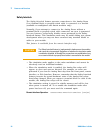Features and Functions 2
34980A User’s Guide 19
The following command selects the 1 A range with 6½ digits of resolution
on channel 2041 (current measurements are allowed only on channels 41
through 44 on the 34921A).
MEAS:CURR:AC? 1,1E-6,(@2041)
You can also select the resolution using the SENSe commands. For example,
the following command specifies a 2-wire ohms measurement with 100Ω of
resolution on channel 1003.
SENS:RES:RES 100,(@1003)
Custom A/D Integration Time
Integration time is the period of time the internal DMM’s analog-to- digital
(A/D) converter samples the input signal for a measurement. Integration
time affects the measurement resolution (for better resolution, use a longer
integration time) and measurement speed (for faster measurements, use a
shorter integration time).
• Integration time is specified in number of power line cycles (PLCs).
Select from 0.02, 0.2, 1, 2, 10, 20, 100, or 200 power line cycles.
The default is 1 PLC.
• Only integral number of power line cycles (1, 2, 10, 20, 100, or 200
PLCs) provide normal mode (line frequency noise) rejection.
• You can also specify integration time directly in seconds (this is called
aperture time). Select a value between 300 µs and 1 second, with
4 µs resolution.
• The only way to control the reading rate for ac measurements is by
changing the channel delay (see “Channel Delay” on page 53) or by
setting the ac filter to the highest frequency limit (see “AC Low
Frequency Filter” on page 36).
• The specified integration time is used for all measurements on the
selected channel. If you have applied Mx+B scaling or have assigned
alarms to the selected channel, those measurements are also made
using the specified integration time. Measurements taken during the
Monitor function also use the specified integration time.


















